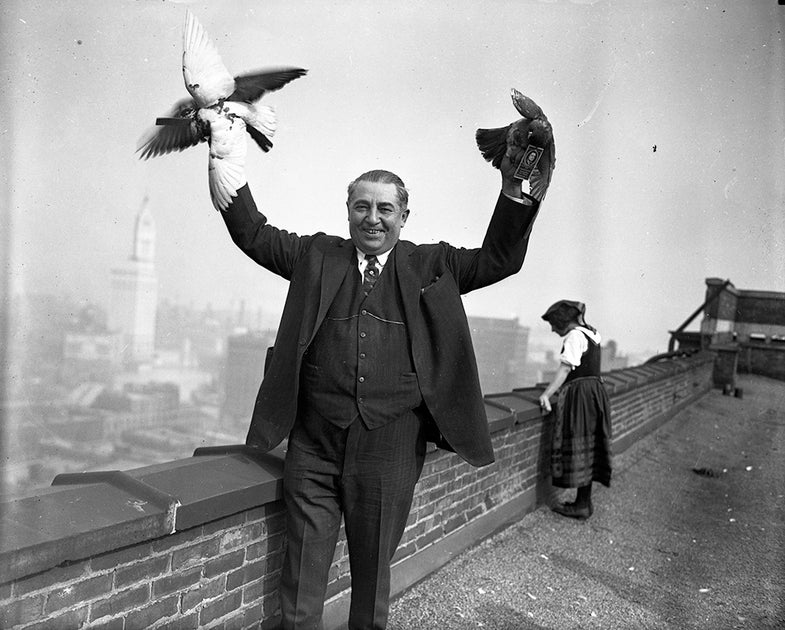Guards wait for John Dillinger
Guards surround the courthouse and jail in Crown Point, Ind., as they wait for John Dillinger’s arrival. A few months earlier Dillinger had escaped from jail in Lima, Ohio with the help of members of his gang. Authorities feared his gang would attempt to rescue their leader a second time. Chicago Tribune photograph for one-time use only in conjunction with reviews or coverage of Gangsters and Grifters by Agate Publishing and the Chicago Tribune
The Lipstick Killer
Detective Chief Walter Storms, second from left, and Capt. Michael Ahern, far right, accompany University of Chicago student William Heirens, 17, to a detective bureau lineup on July 1, 1946. On Jan. 7, 1946, Heirens was convicted of kidnapping, strangling and dismembering Suzanne Degnan as well as murdering Frances Brown, 33, and Josephine Ross, 43, in separate crimes in 1945. On Brown’s apartment wall the murdered wrote in lipstick, “For heaven’s sake, catch me before I kill more. I cannot control myself.” This gave Heirens the nickname “The Lipstick Killer” Chicago Tribune photograph for one-time use only in conjunction with reviews or coverage of Gangsters and Grifters by Agate Publishing and the Chicago Tribune
Joseph “Diamond Joe” Esposito
The FBI credited Joseph “Diamond Joe” Esposito, the beloved Republican boss of the 19th Ward, as being one of the first known Sicilian mafia members to immigrate to the United States. He was involved in bootlegging, extortion, prostitution and labor racketeering, and he was a prime rival of Al Capone before being murdered in 1928. Undated photo. Chicago Tribune photograph for one-time use only in conjunction with reviews or coverage of Gangsters and Grifters by Agate Publishing and the Chicago Tribune
Tillie Klimek and Nellie Stermer-Koulik
Tillie Klimek, right, and her cousin Nellie Stermer-Koulik were accused of poisoning 20 husbands, children and friends with arsenic. “WE have here a woman of average intelligence, a modern housewife and a good cook. When she is among women she is affectionate and it is said, she is the most popular woman in the jail. Yet, the testimony showed, cold bloodedly, without feeling or remorse, she killed three of her husbands and attempted to kill the fourth,” said Judge Marcus Kavanagh as he sentenced her to life in prison. Stermer-Koulik was found not guilty. Chicago Tribune photograph for one-time use only in conjunction with reviews or coverage of Gangsters and Grifters by Agate Publishing and the Chicago Tribune
John Dillinger at Trial
John Dillinger, center, is handcuffed to Deputy Sheriff R. M. Pierce, left, during Dillinger’s murder trial hearing in Crown Point in early February 1934. Dillinger’s trial date was set for March 12, 1934, but he would break out of the Crown Point jail on March 3, 1934. Chicago Tribune photograph for one-time use only in conjunction with reviews or coverage of Gangsters and Grifters by Agate Publishing and the Chicago Tribune
Gertrude “Billie” Murphy
Gertrude “Billie” Murphy, 22, is brought in for questioning in the murder case of Michael Stopec, who was shot and killed in an apartment hotel, circa July 1927. Murphy had been a friend of the marries Stopec and his suspected killer Henry Guardino. The Tribune reported that Stopec and Guardino were “bitter rivals for the favor of Billie” and that Murphy had tried of Guardino and was going to stay with Stopec. Murphy was also married to a man in the Joliet penitentiary. Chicago Tribune photograph for one-time use only in conjunction with reviews or coverage of Gangsters and Grifters by Agate Publishing and the Chicago Tribune
Stateville Prison
State highway policemen restore order in the circular cellblocks at Stateville Prison in Joliet, Ill., after 1,500 convicts rioted on March 18, 1931, lighting several buildings on fire. Three convicts were shot during the rioting; one of them was gravely wounded with a bullet to the abdomen. Chicago Tribune photograph for one-time use only in conjunction with reviews or coverage of Gangsters and Grifters by Agate Publishing and the Chicago Tribune
John Dillinger
FBI agents shot and killed John Dillinger on July 22, 1934, at the Biograph Theater. Here Betty and Rosella Nelson (in bathing suits) view the body of Dillinger, 32, at the Cook County Morgue. In the days following his death, massive crowds lined up outside the morgue to get a glimpse of the notorious public enemy. Chicago Tribune photograph for one-time use only in conjunction with reviews or coverage of Gangsters and Grifters by Agate Publishing and the Chicago Tribune
Richard Loeb and Nathan Leopold Jr.
Richard Loeb, 18, left, and Nathan Leopold Jr., 19, stare at each other after each gave a separate confession to the murder of Bobby Franks, 14. They finally confessed on May 31, 1924 after Leopold’s glasses were found next to Frank’s body at the 121st Street and Pennsylvania railroad tracks. The teenagers said they were out in the remote area to bird-watch. Chicago Tribune photograph for one-time use only in conjunction with reviews or coverage of Gangsters and Grifters by Agate Publishing and the Chicago Tribune
Rose Neary Strangled in Home
Police officers look over the body of well-to-do spinster Rose Neary, 50, who was found murdered in her apartment in the 3200 block of Franklin Boulevard on June 2, 1939. Neary was strangled with cord cut from her kitchen radio; towel was then placed over her head, which as them bashed in with a claw hammer. Her murder was never solved. Chicago Tribune photograph for one-time use only in conjunction with reviews or coverage of Gangsters and Grifters by Agate Publishing and the Chicago Tribune










